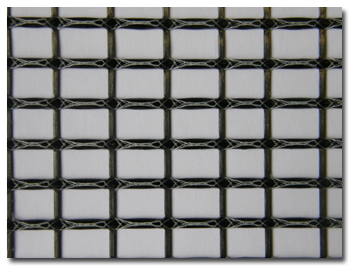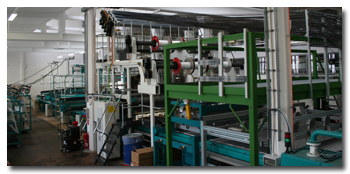OBERTSHAUSEN, Germany — December 5, 2012 — Carbon fibre heavy tows (CFHT) are opening up more and more applications for textile reinforcing materials in the building sector. Carbon fibre heavy tows consist of 50,000 individual filaments and can reduce material costs for a higher fibre volume in each textile concrete-reinforcing layer. This represents a considerable economic advantage over alkali-resistant glass fibres and conventional carbon fibre materials comprising 12,000 individual filaments, which are currently used in textile-reinforced concrete for maintaining and restoring buildings.
A special research project has been carried out at the TU Dresden to produce concrete reinforcement from CFHT. The partner in the project was the textile machinery manufacturer, KARL MAYER MALIMO. A specially modified, industrial Malitronic MULTIAXIAL warp knitting machine developed by KARL MAYER was used in the research work.

Textile made from carbon filament yarns for reinforcing concrete (TU Dresden)
The modifications made related primarily to the elements for delivering the CFHT material in the main reinforcing direction, i.e. the warp yams. The delivery units were modified to permit extremely accurate positioning of the yarns with no damage. The improvements included developing gentle warp yarn brakes for reducing filament breakages and installing combined warp yarn/holding-down sinkers for placing the warp yarns accurately between the needles.
Special components were also integrated for processing the carbon material gently in the adjacent reinforcing direction. These are runners, or transport chains, which use the tension of the weft yarns to guarantee that the CFHT lies parallel and at right-angles to the adjacent reinforcing direction. A weft yarn laying device developed specially for processing 50K carbon filament tows also guarantees large openings and deflection angles which, together with suitable combinations of materials, was a prerequisite for feeding-in the material with minimum damage.
The technical improvements resulted in the development of a Malitronic MULTIAXIAL machine, which enables the CFHT material to be processed extremely accurately and gently to produce multiaxial reinforcement layers. The warp yarns are fixed without being pierced and the weft yarns are fixed in a reduced width during the warp knitting process. Both yarn systems lie completely parallel and stretched in the reinforcing textiles - which has a positive effect on the strain characteristics.

Die Malitronic® MULTIAXIAL in the ITM's technical centre (TU Dresden)
It was possible to improve other relevant, mechanical properties by integrating inline coating and drying processes.
Thanks to the modular construction of the Malitronic MULTIAXIAL, it was possible to incorporate the coating and drying system directly into the industrial multiaxial warp knitting machine.
As well as improving the properties of the reinforcement, the improvements made to the Malitronic MULTIAXIAL also increased the productivity - the machine was running at speeds of up to 560 min-1 during the project.





